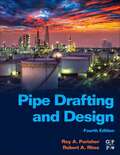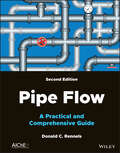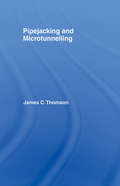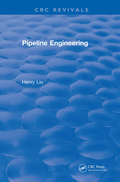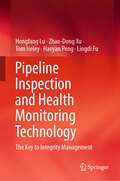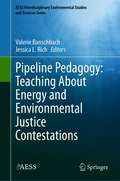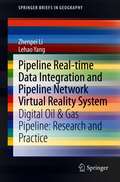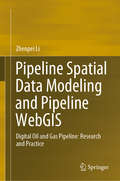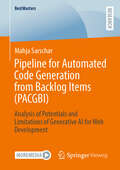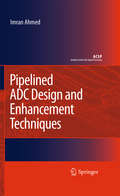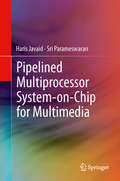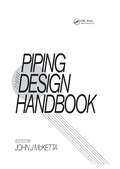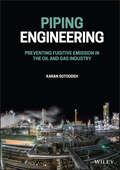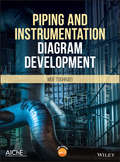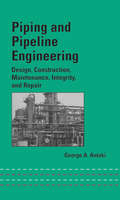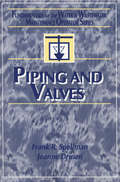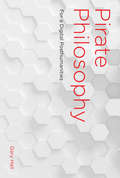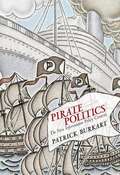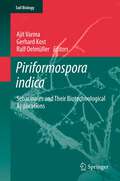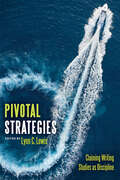- Table View
- List View
Pipe Drafting and Design
by Roy A. Parisher Robert A. RheaPipe Drafting and Design, Fourth Edition is a tried and trusted guide to the terminology, drafting methods, and applications of pipes, fittings, flanges, valves, and more. Those new to this subject will find no better introduction on the topic, with easy step-by-step instructions, exercises, review questions, hundreds of clear illustrations, explanations of drawing techniques, methodology and symbology for piping and instrumentation diagrams, piping arrangement drawings and elevations, and piping isometric drawings. This fully updated and expanded new edition also explains procedures for building 3D models and gives examples of field-scale projects showing flow diagrams and piping arrangement drawings in the real world. The latest relevant standards and codes are also addressed, making this a valuable and complete reference for experienced engineers, too. Provides tactics on the drafting and design of pipes, from fundamentals to detailed advice on the development of piping drawings, using manual and CAD techniques Covers 3-D model images that provide an uncommon opportunity to visualize an entire piping facility Includes exercises and questions designed for review and practice Introduces the latest 3D modeling software programs and 3D scanning systems
Pipe Dreams: The Urgent Global Quest to Transform the Toilet
by Chelsea WaldFrom an award-winning science journalist, a lively, informative, and humorous deep dive into the future of the toilet—from creative uses for harvested &“biosolids,&” to the bold engineers dedicated to bringing safe sanitation to the billions of people worldwide living without—for fans of popular science bestsellers by Mary Roach. Most of us do not give much thought to the centerpiece of our bathrooms, but the toilet is an unexpected paradox. On the one hand, it is a modern miracle: a ubiquitous fixture in a vast sanitation system that has helped add decades to human lifespan by reducing disease. On the other hand, the toilet is also a tragic failure: less than half of the world&’s population can access a toilet that safely manages bodily waste, including many right here in the United States. And it is inefficient, squandering clean water as well as the nutrients and energy contained in the waste we flush away. While we see radical technological change in almost every other aspect of our lives, we remain stuck in a sanitation status quo—in part because the topic of toilets is taboo. Fortunately, there&’s hope—and Pipe Dreams daringly profiles the growing army of scientists, engineers, philanthropists, entrepreneurs, and activists worldwide who are overcoming their aversions and focusing their formidable skills on making toilets accessible and healthier for all. This potential revolution in sanitation has many benefits, including reducing inequalities, mitigating climate change and water scarcity, improving agriculture, and optimizing health. Author Chelsea Wald takes us on a wild world tour from a compost toilet project in Haiti, to a plant in the Netherlands that harvests used toilet paper from sewage, and shows us a bot that hangs out in manholes to estimate opioid use in a city, among many other fascinating developments. Much more than a glorified trash can, the toilet, Wald maintains, holds the power to help solve many of the world&’s problems, if only we can harness it.
Pipe Flow
by Donald C. Rennels Hobart M. HudsonPipe Flow provides the information required to design and analyze the piping systems needed to support a broad range of industrial operations, distribution systems, and power plants. Throughout the book, the authors demonstrate how to accurately predict and manage pressure loss while working with a variety of piping systems and piping components.The book draws together and reviews the growing body of experimental and theoretical research, including important loss coefficient data for a wide selection of piping components. Experimental test data and published formulas are examined, integrated and organized into broadly applicable equations. The results are also presented in straightforward tables and diagrams.Sample problems and their solution are provided throughout the book, demonstrating how core concepts are applied in practice. In addition, references and further reading sections enable the readers to explore all the topics in greater depth.With its clear explanations, Pipe Flow is recommended as a textbook for engineering students and as a reference for professional engineers who need to design, operate, and troubleshoot piping systems. The book employs the English gravitational system as well as the International System (or SI).
Pipe Flow: A Practical and Comprehensive Guide
by Donald C. RennelsPipe Flow Provides detailed coverage of hydraulic analysis of piping systems, revised and updated throughout Pipe Flow: A Practical and Comprehensive Guide provides the information required to design and analyze piping systems for distribution systems, power plants, and other industrial operations. Divided into three parts, this authoritative resource describes the methodology for solving pipe flow problems, presents loss coefficient data for a wide range of piping components, and examines pressure drop, cavitation, flow-induced vibration, and other flow phenomena that affect the performance of piping systems. Throughout the book, sample problems and worked solutions illustrate the application of core concepts and techniques. The second edition features revised and expanded information throughout, including an entirely new chapter that presents a mixing section flow model for accurately predicting jet pump performance. This edition includes additional examples, supplemental problems, and a new appendix of the speed of sound in water. With clear explanations, expert guidance, and precise hydraulic computations, this classic reference text remains required reading for anyone working to increase the quality and efficiency of modern piping systems. Discusses the fundamental physical properties of fluids and the nature of fluid flow Demonstrates the accurate prediction and management of pressure loss for a variety of piping components and piping systems Reviews theoretical research on fluid flow in piping and its components Presents important loss coefficient data with straightforward tables, diagrams, and equations Includes full references, further reading sections, and numerous example problems with solution Pipe Flow: A Practical and Comprehensive Guide, Second Edition is an excellent textbook for engineering students, and an invaluable reference for professional engineers engaged in the design, operation, and troubleshooting of piping systems.
Pipejacking & Microtunnelling
by James ThomsonCovers development of trenchless technology; pipejacking and microtunnelling methods equipment: shields and tunnel boring machines; pipejacking: line, drive pit, top side; equipment: microtunnelling; design concepts.
Pipeline Engineering (CRC Press Revivals)
by Henry LiuPipeline engineering has struggled to develop as a single field of study due to the wide range of industries and government organizations using different types of pipelines for all types of solids, liquids, and gases. This fragmentation has impeded professional development, job mobility, technology transfer, the diffusion of knowledge, and the movement of manpower. No single, authoritative course or book has existed to unite practitioners.In response, Pipeline Engineering covers the essential aspects and types of pipeline engineering in a single volume. This work is divided into two parts. Part I, Pipe Flows, delivers an integrated treatment of all variants of pipe flow including incompressible and compressible, Newtonian and non-Newtonian, slurry and multiphase flows, capsule flows, and pneumatic transport of solids. Part II, Engineering Considerations, summarizes the equipment and methods required for successful planning, design, construction, operation, and maintenance of pipelines. By addressing the fundamentals of pipeline engineering-concepts, theories, equations, and facts-this groundbreaking text identifies the cornerstones of the discipline, providing engineers with a springboard to success in the field. It is a must-read for all pipeline engineers.
Pipeline Inspection and Health Monitoring Technology: The Key to Integrity Management
by Zhao-Dong Xu Hongfang Lu Tom Iseley Haoyan Peng Lingdi FuThis book includes six chapters aiming to introduce global pipeline inspection and health monitoring technologies comprehensively. The pipeline is the blood vessel of the energy system and a vital lifeline project. After many years of service, the pipeline gradually enters the aging stage. Pipeline inspection and health monitoring can effectively reduce the failure and accident risks of the pipeline, and it is conducive to integrity management. Through case analysis, practitioners can have a deeper understanding of the application of related technologies.
Pipeline Pedagogy: Teaching About Energy and Environmental Justice Contestations (AESS Interdisciplinary Environmental Studies and Sciences Series)
by Valerie Banschbach Jessica L. RichThe proliferation of pipelines to transport oil and natural gas represents a major area of contestation in the landscape of energy development. Battles over energy pipelines pit private landowners, local community representatives, and environmentalists against energy corporations and industry supporters, sometimes drawing opposition and attention from well beyond the impacted regions, as in the case of the Standing Rock/Dakota Access Pipeline. Stakeholders must navigate complex government regulatory processes, interpret technical and scientific reports, and endure lengthy and expensive court battles. As with other forms of environmental injustice, the contentious construction of pipelines often disproportionately impacts communities of lower economic development, people of color, and indigenous peoples; pipelines also pose potential short and long-term health and safety threats. With the expansion of energy pipelines carrying fracked oil and gas across the United States and abroad, the moment is ripe for teaching about pipeline projects and engaging students and community members in learning about methods for mobilization. Our volume examines pedagogical opportunities, challenges, and interventions that campus-community engagement, and other kinds of community engagement, produce in relation to infrastructuring in the form of pipeline development.
Pipeline Real-time Data Integration and Pipeline Network Virtual Reality System: Digital Oil & Gas Pipeline: Research and Practice (SpringerBriefs in Geography)
by Zhenpei Li Lehao YangAs the second volume of the "Digital Oil & Gas Pipeline: Research and Practice" series of monographs, this book introduces the implementation strategies, examples and technical roadmaps of two important aspects of the Digital Oil & Gas Pipeline construction: pipeline real-time data integration and pipeline network virtual reality system. Two example of pipeline real-time data integration are elaborated: integration of pipeline WebGIS (Geographic Information System) and pipeline SCADA (Supervisory Control and Data Acquisition) via OPC (OLE for Process Control) technology, integration of pipeline network virtual reality system and pipeline SCADA via OPC, JNI (Java Native Interface) and SAI (Scene Access Interface). The pipeline network virtual reality system aims for the pipeline virtual expression, interaction, and 3D visual management. It can be used for pipeline route visual design and plan, immersive pipeline industry training, remote visual supervision and control, etc. The implementation details of the pipeline network virtual reality system, including 3D pipeline and terrain modeling with X3D (Extensible 3D) technology, improving large-scene display performance and speed in the network environment using LOD (Level of Detail) technology, interaction of virtual pipeline scenes, and pipeline 3D visual monitoring, are also introduced. The knowledge and experience delivered by this book will provide useful reference for the readers from the industries of oil & gas pipeline, GIS, Virtual Reality, industrial control, etc.
Pipeline Spatial Data Modeling and Pipeline WebGIS: Digital Oil and Gas Pipeline: Research and Practice (Springerbriefs In Geography Ser.)
by Zhenpei LiThis monograph, which is the first book focusing on "Digital Oil & Gas Pipeline", introduces the author’s long-term research and practice on this topic. It introduces the latest research on the core technologies of the Digital Oil & Gas Pipeline, such as WebGIS, GIS Web Services, pipeline supervisory control and data acquisition (SCADA), OLE for Process Control, networked virtual reality, and Extensible 3D. The keys to the Digital Oil & Gas Pipeline, including pipeline spatial data model, pipeline WebGIS, integrity of pipeline SCADA and pipeline GIS, pipeline networked virtual reality system, are also elaborated. The knowledge and experience delivered by this monograph will provide a useful reference for readers from the industries in Oil & Gas Storage and Transportation, pipeline automation, GIS, Virtual Reality, and related fields.
Pipeline Valve Technology: A Practical Guide
by Karan SotoodehThis book covers the life cycle of pipeline valves, the largest and most essential valves in offshore pipeline engineering. Discussing the design process, testing, production, transportation, installation, and maintenance, the book also covers the risk analysis required to assess the reliability of these valves. Pipeline valves require particular attention to ensure they are safely designed, installed, and maintained, due to the high stakes. Failure would result in environmental pollution, the destruction of expensive assets, and potential loss of life. Proper installation and upkeep require specialist processes throughout the life cycle of the valve. This book is a key guide to these processes. Beginning by looking at the design of pipeline valves, this book details how conserving weight and space is prioritized, how materials are chosen, how thickness is calculated, and how leakage is minimized. It then discusses production and specific welding techniques to bond dissimilar materials, alongside casting and machining. Building on other discussions in the text with case studies and questions and answers for self-study, this book is the ideal guide to pipeline valves. This book will be of interest to professionals in the industries of offshore oil and gas, material engineering, coatings, mechanical engineering, and piping. It will also be relevant to students studying coating and welding, or mechanical, piping, or petroleum engineering.
Pipeline for Automated Code Generation from Backlog Items: Analysis of Potentials and Limitations of Generative AI for Web Development (BestMasters)
by Mahja SarscharThis book investigates the potential and limitations of using Generative AI (GenAI) in terms of quality and capability in agile web development projects using React. For this purpose, the Pipeline for Automated Code Generation from Backlog Items (PACGBI) was implemented and used in a case study to analyse the AI-generated code with a mix-method approach. The findings demonstrated the ability of GenAI to rapidly generate syntactically correct and functional code with Zero-Shot prompting. The PACGBI showcases the potential for GenAI to automate the development process, especially for tasks with low complexity. However, this research also identified challenges with code formatting, maintainability, and user interface implementation, attributed to the lack of detailed functional descriptions of the task and the appearance of hallucinations. Despite these limitations, the book underscores the significant potential of GenAI to accelerate the software development process and highlights the need for a hybrid approach that combines GenAI's strengths with human expertise for complex tasks. Further, the findings provide valuable insights for practitioners considering GenAI integration into their development processes and set a foundation for future research in this field.
Pipelined ADC Design and Enhancement Techniques
by Imran AhmedPipelined ADCs have seen phenomenal improvements in performance over the last few years. As such, when designing a pipelined ADC a clear understanding of the design tradeoffs, and state of the art techniques is required to implement today's high performance low power ADCs.
Pipelined Multiprocessor System-on-Chip for Multimedia
by Haris Javaid Sri ParameswaranThis book describes analytical models and estimation methods to enhance performance estimation of pipelined multiprocessor systems-on-chip (MPSoCs). A framework is introduced for both design-time and run-time optimizations. For design space exploration, several algorithms are presented to minimize the area footprint of a pipelined MPSoC under a latency or a throughput constraint. A novel adaptive pipelined MPSoC architecture is described, where idle processors are transitioned into low-power states at run-time to reduce energy consumption. Multi-mode pipelined MPSoCs are introduced, where multiple pipelined MPSoCs optimized separately are merged into a single pipelined MPSoC, enabling further reduction of the area footprint by sharing the processors and communication buffers. Readers will benefit from the authors' combined use of analytical models, estimation methods and exploration algorithms and will be enabled to explore billions of design points in a few minutes.
Piping Design Handbook
by John J. MckettaThis encyclopedic volume covers almost every phase of piping design - presenting procedures in a straightforward way.;Written by 82 world experts in the field, the Piping Design Handbook: details the basic principles of piping design; explores pipeline shortcut methods in an in-depth manner; and presents expanded rules of thumb for the piping desig
Piping Engineering: Preventing Fugitive Emission in the Oil and Gas Industry
by Karan SotoodehEliminate or reduce unwanted emissions with the piping engineering techniques and strategies contained in this book Piping Engineering: Preventing Fugitive Emission in the Oil and Gas Industry is a practical and comprehensive examination of strategies for the reduction or avoidance of fugitive emissions in the oil and gas industry. The book covers key considerations and calculations for piping and fitting design and selection, maintenance, and troubleshooting to eliminate or reduce emissions, as well as the various components that can allow for or cause them, including piping flange joints. The author explores leak detection and repair (LDAR), a key technique for managing fugitive emissions. He also discusses piping stresses, like principal, displacement, sustained, occasional, and reaction loads, and how to calculate these loads and acceptable limits. Various devices to tighten the bolts for flanges are described, as are essential flange fabrications and installation tolerances. The book also includes: Various methods and calculations for corrosion rate calculation, flange leakage analysis, and different piping load measurements Industry case studies that include calculations, codes, and references Focuses on critical areas related to piping engineering to prevent emission, including material and corrosion, stress analysis, flange joints, and weld joints Coverage of piping material selection for offshore oil and gas and onshore refineries and petrochemical plantsIdeal for professionals in the oil and gas industry and mechanical and piping engineers, Piping Engineering: Preventing Fugitive Emission in the Oil and Gas Industry is also a must-read resource for environmental engineers in the public and private sectors.
Piping and Instrumentation Diagram Development
by Moe ToghraeiAn essential guide for developing and interpreting piping and instrumentation drawings Piping and Instrumentation Diagram Development is an important resource that offers the fundamental information needed for designers of process plants as well as a guide for other interested professionals. The author offers a proven, systemic approach to present the concepts of P&ID development which previously were deemed to be graspable only during practicing and not through training. This comprehensive text offers the information needed in order to create P&ID for a variety of chemical industries such as: oil and gas industries; water and wastewater treatment industries; and food industries. The author outlines the basic development rules of piping and instrumentation diagram (P&ID) and describes in detail the three main components of a process plant: equipment and other process items, control system, and utility system. Each step of the way, the text explores the skills needed to excel at P&ID, includes a wealth of illustrative examples, and describes the most effective practices. This vital resource: Offers a comprehensive resource that outlines a step-by-step guide for developing piping and instrumentation diagrams Includes helpful learning objectives and problem sets that are based on real-life examples Provides a wide range of original engineering flow drawing (P&ID) samples Includes PDF’s that contain notes explaining the reason for each piece on a P&ID and additional samples to help the reader create their own P&IDs Written for chemical engineers, mechanical engineers and other technical practitioners, Piping and Instrumentation Diagram Development reveals the fundamental steps needed for creating accurate blueprints that are the key elements for the design, operation, and maintenance of process industries.
Piping and Pipeline Engineering: Design, Construction, Maintenance, Integrity, and Repair (Mechanical Engineering Ser. #Vol. 159)
by George A. AntakiTaking a big-picture approach, Piping and Pipeline Engineering: Design, Construction, Maintenance, Integrity, and Repair elucidates the fundamental steps to any successful piping and pipeline engineering project, whether it is routine maintenance or a new multi-million dollar project. The author explores the qualitative details, calculations, and t
Piping and Valves (Fundamentals for the Water and Wastewater Main Operator Series)
by Frank R. Spellman Joanne DrinanThis volume in the Fundamentals for the Water and Wastewater Main Operator series covers the basics of piping and valves in water and wastewater plants, including details on fittings, strainers, filters, traps and control systems. The book explains how pipes and valves are used to feed materials (e.g., chemicals) into influents and effluents and also siphon off unwanted liquid and gaseous byproduct. Also covered is how pipes are developed into systems and subsystems and coordinated into a plant-wide functioning unit.
Pirate Philosophy: For a Digital Posthumanities (Leonardo)
by Gary HallHow philosophers and theorists can find new models for the creation, publication, and dissemination of knowledge, challenging the received ideas of originality, authorship, and the book. In Pirate Philosophy, Gary Hall considers whether the fight against the neoliberal corporatization of higher education in fact requires scholars to transform their own lives and labor. Is there a way for philosophers and theorists to act not just for or with the antiausterity and student protestors—“graduates without a future”—but in terms of their political struggles? Drawing on such phenomena as peer-to-peer file sharing and anticopyright/pro-piracy movements, Hall explores how those in academia can move beyond finding new ways of thinking about the world to find instead new ways of being theorists and philosophers in the world.Hall describes the politics of online sharing, the battles against the current intellectual property regime, and the actions of Anonymous, LulzSec, Aaron Swartz, and others, and he explains Creative Commons and the open access, open source, and free software movements. But in the heart of the book he considers how, when it comes to scholarly ways of creating, performing, and sharing knowledge, philosophers and theorists can challenge not just the neoliberal model of the entrepreneurial academic but also the traditional humanist model with its received ideas of proprietorial authorship, the book, originality, fixity, and the finished object. In other words, can scholars and students today become something like pirate philosophers?
Pirate Politics
by Patrick BurkartThe Swedish Pirate Party emerged as a political force in 2006 when a group of software programmers and file-sharing geeks protested the police takedown of The Pirate Bay, a Swedish file-sharing search engine. The Swedish Pirate Party, and later the German Pirate Party, came to be identified with a "free culture" message that came into conflict with the European Union's legal system. In this book, Patrick Burkart examines the emergence of Pirate politics as an umbrella cyberlibertarian movement that views file sharing as a form of free expression and advocates for the preservation of the Internet as a commons. He links the Pirate movement to the Green movement, arguing that they share a moral consciousness and an explicit ecological agenda based on the notion of a commons, or public domain. The Pirate parties, like the Green Party, must weigh ideological purity against pragmatism as they move into practical national and regional politics. Burkart uses second-generation critical theory and new social movement theory as theoretical perspectives for his analysis of the democratic potential of Pirate politics. After setting the Pirate parties in conceptual and political contexts, Burkart examines European antipiracy initiatives, the influence of the Office of the U.S. Trade Representative, and the pressure exerted on European governance by American software and digital exporters. He argues that pirate politics can be seen as "cultural environmentalism," a defense of Internet culture against both corporate and state colonization.
Pirate Politics: The New Information Policy Contests (The Information Society Series)
by Patrick BurkartAn examination of the Pirate political movement in Europe analyzes its advocacy for free expression and the preservation of the Internet as a commons.The Swedish Pirate Party emerged as a political force in 2006 when a group of software programmers and file-sharing geeks protested the police takedown of The Pirate Bay, a Swedish file-sharing search engine. The Swedish Pirate Party, and later the German Pirate Party, came to be identified with a “free culture” message that came into conflict with the European Union's legal system. In this book, Patrick Burkart examines the emergence of Pirate politics as an umbrella cyberlibertarian movement that views file sharing as a form of free expression and advocates for the preservation of the Internet as a commons. He links the Pirate movement to the Green movement, arguing that they share a moral consciousness and an explicit ecological agenda based on the notion of a commons, or public domain. The Pirate parties, like the Green Party, must weigh ideological purity against pragmatism as they move into practical national and regional politics.Burkart uses second-generation critical theory and new social movement theory as theoretical perspectives for his analysis of the democratic potential of Pirate politics. After setting the Pirate parties in conceptual and political contexts, Burkart examines European antipiracy initiatives, the influence of the Office of the U.S. Trade Representative, and the pressure exerted on European governance by American software and digital exporters. He argues that pirate politics can be seen as “cultural environmentalism,” a defense of Internet culture against both corporate and state colonization.
Piriformospora indica
by Ajit Varma Gerhard Kost Ralf OelmüllerSebacinales have emerged as a fascinating order with mutualistic plant-fungal symbionts that consists of exclusively beneficial fungi. This volume of Soil Biology presents an overview of the current results in Sebacinales research with a focus on the potential of these fungi in crop improvement and stress tolerance. The authors demonstrate that Sebacinales are not only extremely versatile in their associations with roots, but are also almost universally present as symptomless endophytes. With this extraordinary diversity, Sebacinales with the key fungus Piriformospora indica might possess remarkable significance in natural ecosystems. Their biotechnological applications are expected to improve the quality of crops while maintaining ecologically and economically sustainable production systems.
Pit Lasses: Women and Girls in Coalmining c.1800–1914
by Denise BatesWomen have long been recognized as the backbone of coalmining communities, supporting their men. Less well known is the role which they played as the industry developed, working underground alongside their husband or father, moving the coal which he had cut. The year 2012 is significant as it is the 170th anniversary of the publication of the Report of the Commission into the Employment of Children and Young People in Coal Mines (May 1842). The report findings included the revelation that in some mines half-dressed women worked alongside naked men. The resulting outrage led to the banning of females working underground three months later. The Report of the Commission has been neglected as a source for many decades with the same few quotations regularly being used to illustrate the same headline points. And yet about 500 women and girls gave statements about what mining was like in 1841 and in earlier years in different parts of the country. In conjunction with the 1841 census it paints a comprehensive, though previously unexplored picture of the work of a female miner, how she lived when not at work, how she was regarded by the wider community and what she could achieve. Although banned from working underground, women were still allowed to work above ground after 1842. In the second half of the nineteenth century around 3,000 women continued to be employed at the pit head though this was increasingly confined to the pit brow lasses of Lancashire. This book examines the life of the female miner in the nineteenth century through to the outbreak of the Great War, both at work and away from it, drawing out the largely untapped evidence within contemporary sources - and challenging received wisdoms.
Pivotal Strategies: Claiming Writing Studies as Discipline
by Lynn C. LewisPivotal Strategies examines the rhetorical contexts and motivations that determine how and why people choose writing studies as a discipline, especially as the field begins to take more seriously an antiracist imperative that requires more conscious listening and promotion of work from scholars representing traditionally underrepresented voices. Because undergraduate degrees in writing studies are relatively new, claiming the discipline has required reinvention and revision at personal and professional levels far different than any other discipline. Suspicions about the viability of the discipline linger in many departments and universities, as well as outside the academy, leading writing studies scholars to develop innovative strategies to deal with covertly hostile attitudes. Within the collection, contributors name explicit claiming strategies from the discipline’s beginnings to the contemporary moment, locating opportune spaces, negotiating identities and fostering resilience, and developing allegiances by foregrounding their embodiment as underrepresented members of academia through a commitment to social justice and equity. Responding to current conversations on the worth of education with honest stories about the burdens and joys of becoming and being an academic, Pivotal Strategies features a spectrum of voices across racial, gender, class, and age categories. This collection not only makes the discipline more visible but also helps map the contemporary state of writing studies.
